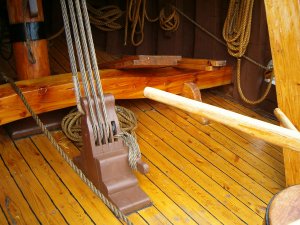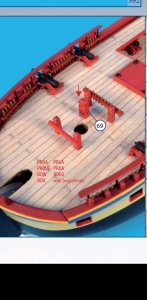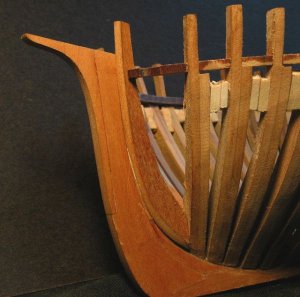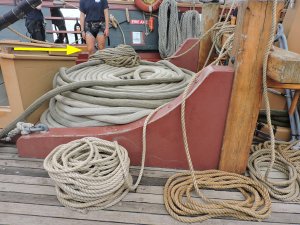-

Win a Free Custom Engraved Brass Coin!!!
As a way to introduce our brass coins to the community, we will raffle off a free coin during the month of August. Follow link ABOVE for instructions for entering.
You are using an out of date browser. It may not display this or other websites correctly.
You should upgrade or use an alternative browser.
You should upgrade or use an alternative browser.
Knightheads were the extended forward most timbers on a ship...Hawse timbers really, parallel to the stem, that formed a “bitt” to support the bowsprit. The top, or “knight head” itself could be used for belaying lines.
- Joined
- Dec 1, 2016
- Messages
- 6,299
- Points
- 728

- Joined
- Dec 1, 2016
- Messages
- 6,299
- Points
- 728

that part 69 is not a knighthead however way back in the 1600s a head was carved on the top of the post and it was referred to as the knight bitt or knighthead bitt.
sometimes called a jeer bitt or ramhead block. A "BITT" is an upright post used to secure rigging line or used for rigging when pullies are added.
as the web connects more international model ship builders obscure names of parts become lost in translation
its name depends on what country the ship is from and the era of the ship but it is not a knighthead
here is a ramhead block like your 69 but a different style

sometimes called a jeer bitt or ramhead block. A "BITT" is an upright post used to secure rigging line or used for rigging when pullies are added.
as the web connects more international model ship builders obscure names of parts become lost in translation
its name depends on what country the ship is from and the era of the ship but it is not a knighthead
here is a ramhead block like your 69 but a different style

Last edited:
- Joined
- Dec 1, 2016
- Messages
- 6,299
- Points
- 728

to answer you question as what it was used for I don't know because I know little about rigging. If I were to guess it might be part of the rigging that lowers or raised the yards.
- Joined
- Dec 1, 2016
- Messages
- 6,299
- Points
- 728

Dave’s got it.
@Dave Stevens (Lumberyard) thank you sir. Great lesson, I appreciate it very much! Now I know almost all I need... remains to search the greek word for the rahmhead block...
Christos
Christos
@DocBlake it seems I confused the knighthead with the knight. The first a structure element and the second a rigging equipment or tool.
The later called (as Dave said) also ramhead block or bitt, is positioned off centre near the mast and is used to lift the lower yards and the upper mast parts.
Still a question: was it used together with the capstans or was just working by pulling the ropes with bear hands?
Christos
The later called (as Dave said) also ramhead block or bitt, is positioned off centre near the mast and is used to lift the lower yards and the upper mast parts.
Still a question: was it used together with the capstans or was just working by pulling the ropes with bear hands?
Christos
In your picture piece 69, in my opinion, would be called a jeers bitt, used in conjunction with the jeers block found at the top of the mast. These were used mainly to raise and lower the yards. As Dave has said some terminology is very confusing and changes with time and style of ships. Although I have never heard of a ramhead block I would certainly not say they are not named as such. It is doing the same job as the jeers bitt, it may get it's name from the ramshead style of cleat on the side of it.
It is best to keep in mind that any bitt's main function is for belaying lines, unless it is equipped with sheaves then it would have a dual purpose of raising and lowering yards and belaying. In your picture there are four different styles of bitts all with different names and purposes but the same basic function of belaying lines.
The capstan, basically a vertical windlass, was used for the lifting of heavy loads which could include yards, ship's boats and such but it's main function was the anchor. Whether it was used with the jeers bitts and blocks to lift yards is hard to say but certainly could be. I would think that in the process of getting underway the capstan would be busy with the anchor, and with so many hands on deck I would also think for the most part the yards would be raised by hand.
To further confuse things there is also an apparatus called the jeers capstan which is a large block strung between two masts, typically the fore and main, that is used to raise and lower yards and other heavy loads.
It is best to keep in mind that any bitt's main function is for belaying lines, unless it is equipped with sheaves then it would have a dual purpose of raising and lowering yards and belaying. In your picture there are four different styles of bitts all with different names and purposes but the same basic function of belaying lines.
The capstan, basically a vertical windlass, was used for the lifting of heavy loads which could include yards, ship's boats and such but it's main function was the anchor. Whether it was used with the jeers bitts and blocks to lift yards is hard to say but certainly could be. I would think that in the process of getting underway the capstan would be busy with the anchor, and with so many hands on deck I would also think for the most part the yards would be raised by hand.
To further confuse things there is also an apparatus called the jeers capstan which is a large block strung between two masts, typically the fore and main, that is used to raise and lower yards and other heavy loads.
@DonRobinson thank you very much for all this interesting information. Am very happy now that I got the correct picture of this equipment. The replica ship has another one near the main mast, so I figure it was probably used for the lower and heavier yards.






